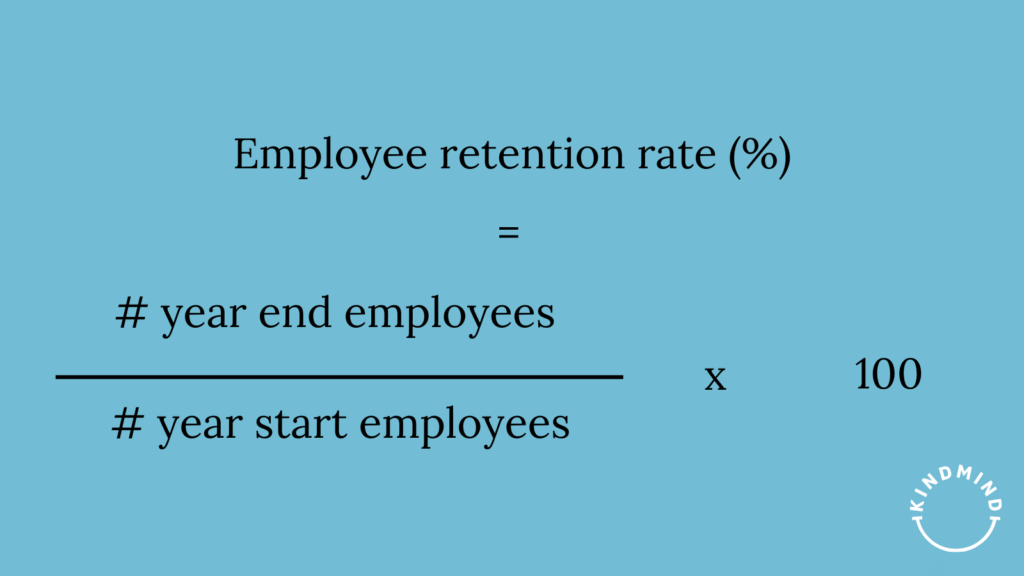Struggling with how to measure your employee retention rate? Worry no more; in today’s blog post, here at Kind Mind, we will be taking you through everything you need to know, from how to calculate retention and what a good benchmark should be.
What is employee retention?
Employee retention refers to an organisation’s ability to keep employees over a specified period. This unit of measurement is called the “employee retention rate”.
Retaining talented and experienced employees can benefit a business greatly because they have the knowledge and skills to perform their jobs effectively. Additionally, retaining employees can save organisations significant costs for recruiting, hiring, and training new staff. All go towards building a more robust business, where creativity and innovation go hand in hand with good work ethics and happy employees.
There are various strategies you can use to improve employee retention. These include:
- offering competitive compensation packages
- providing opportunities for professional development
- creating a positive work environment
- recognising and rewarding employees’ contributions
- and providing a clear path for career advancement.
We will talk more about this later.
But first, why should we measure retention rates?
Why measure employee retention at all?
Measuring employee retention is essential for several reasons:
- Cost – Employee turnover is costly, and replacing employees who leave your business can be expensive. Measuring employee retention can help you identify areas to improve employee satisfaction and reduce turnover costs.
- Performance – High employee turnover can impact your business’s performance, leading to a loss of knowledge, experience, and skills. Measuring employee retention can help you identify potential skill gaps in your talent pool and take steps to address them.
- Culture – An organisation’s culture significantly affects employee experience. Measuring employee retention can help you identify areas where you need to improve your culture and create a more positive work environment.
- Benchmarking – Measuring employee retention can provide a benchmark for comparison with other organisations in the same industry. This can help you identify areas to improve retention efforts and develop strategies to retain top talent.
The critical thing to remember is that by measuring points in your business, like retention, you can capture factual data to help you make more informed decisions.
The employee retention rate formula
How to measure employee retention rate, that is the question!
The employee retention rate is a metric that measures the percentage of employees who remain with your business over a certain period, typically a year. Retention is calculated by dividing the number of employees who stay with your business at the end of the period by the number of employees who started the period. The result is multiplied by 100 to get the retention rate as a percentage.

For example, if you have 1,000 employees at the beginning of the year and 900 of them are still with the company at the end of the year, the retention rate would be
Retention Rate = (900 / 1,000) x 100 = 90%
A high employee retention rate generally indicates that employees are satisfied with their jobs, the company culture, and the overall work environment, which can lead to increased productivity, better customer service, and reduced costs associated with turnover.
On the other hand, a low retention rate may indicate issues with employee morale, job satisfaction, or the work environment, which can negatively impact the organisation’s performance and reputation.
The UK’s benchmark employee retention rate
The UK has no specific benchmark for employee retention rates. In your research, you will find that rates vary by industry, organisation size, and other factors. However, HR professionals say you should look at a benchmark rate of around 85%.
It’s worth noting that while benchmarking can help you understand how your organisation compares to others in your industry, it’s not the only factor to consider. You should focus on your specific goals, challenges, and employee needs when developing retention strategies.
One thing to remember – in creating your business benchmark, 100% retention isn’t an ideal figure to aim for because you want under-performers and disenchanted employees to move on, giving room for higher-performing talent to replace them.
Don’t worry if you are seeing a little less than 85% this year; after the pandemic and now with hybrid working, most businesses have likely witnessed a drop in retention rates. It’s now time to work on fixing the issue.

How often should you measure employee retention rates?
In general, it’s a good practice to measure employee retention annually. This allows you to identify trends over time and make data-driven decisions about retention strategies.
However, if you are experiencing high turnover rates or other issues related to employee retention, it may be necessary to measure retention more frequently, such as quarterly or biannually. This allows you to track progress on your retention efforts and make adjustments as needed.
It’s also important to note that measuring employee retention is an ongoing process. You should regularly review and analyse retention data to clarify what’s happening in your business.
Other common employee retention KPIs to consider
In asking “how to measure employee retention rate” it is important to consider what other measurement points you need to take.
Here are some common employee retention Key Performance Indicators (KPIs) that you can measure alongside your retention rate formula. Combined, they will give you a more detailed picture of why employees leave and how they generally feel about working for your business.
Turnover Rate
The turnover rate measures the percentage of employees who leave your organisation over a given period (including retirees). It’s the opposite of retention. A high turnover rate indicates that employees leave the organisation faster than they are being replaced.
Voluntary Turnover Rate
The voluntary turnover rate measures the percentage of employees who voluntarily leave your organisation. A high voluntary turnover rate suggests employees are dissatisfied with their jobs or the organisation and choose to leave.
Absenteeism Rate
The absenteeism rate measures the percentage of scheduled work time employees are absent due to illness, vacation, or other reasons. High absenteeism rates can indicate low morale, job dissatisfaction, or burnout.
Employee Engagement
Employee engagement measures employees’ commitment, enthusiasm, and dedication to their jobs and the organisation. Engaged employees are more likely to stay with the organisation, reducing turnover rates.
Performance Ratings
Performance ratings measure how well employees meet their job requirements and expectations. Low-performance ratings may indicate job dissatisfaction or lack of motivation, leading to higher turnover rates.
Time to Fill Vacancies
Time to fill vacancies measures the time it takes to fill open positions within your organisation. A longer rate may indicate a need for more qualified candidate targeting or a lack of interest in the organisation. Remember, a lack of employee satisfaction can damage your employment reputation.
By tracking these KPIs, you can identify potential issues and take action more effectively to improve your overall retention rate.
How to start improving your employee retention rate
Improving employee retention rates requires a multifaceted approach that addresses the root causes of employee turnover. Here are some strategies to help improve employee retention rates:
- Create a positive work environment – A positive work environment can improve employee morale and job satisfaction. Encourage positive interactions between employees, recognise employee contributions, and promote work-life balance.
- Provide opportunities for career development – Provide employees with opportunities for professional development and career advancement. Offer training programs, mentorship, and career coaching to help employees reach their full potential.
- Offer competitive compensation and benefits – Ensure employees receive fair compensation and benefits that are competitive within the industry. Conduct regular salary reviews and offer benefits that meet employees’ needs.
- Encourage work-life balance – Encourage employees to maintain a healthy work-life balance by offering flexible work arrangements, such as remote work, flexible hours, and vacation time.
- Build a strong company culture – Build a strong company culture that aligns with employees’ values and promotes a sense of community and belonging. Ensure employees feel valued, respected, and included.
- Provide opportunities for employee feedback – Regularly gather feedback from employees to understand their needs, concerns, and suggestions for improvement. Use this feedback to improve the organisation’s processes, policies, and culture.
- Focus on employee engagement – Employee engagement is crucial for retention. Encourage employee engagement through regular communication, team-building activities, and employee recognition programs.
- Include employee wellness – Our extensive research has discovered employee wellness is directly related to employee retention rates. Invest in wellness provisions to enhance your employee experience and benefit from happier, healthier and more productive staff.
By implementing these strategies, organisations can improve employee retention rates, reduce turnover costs, and maintain a stable and productive workforce.
Good luck.
Looking for more guides on employee retention? Read our latest articles here.






